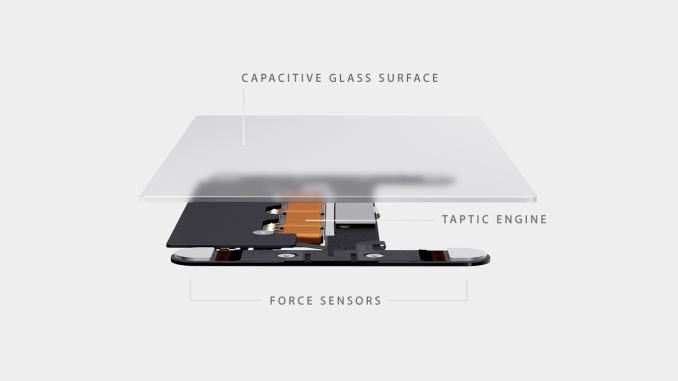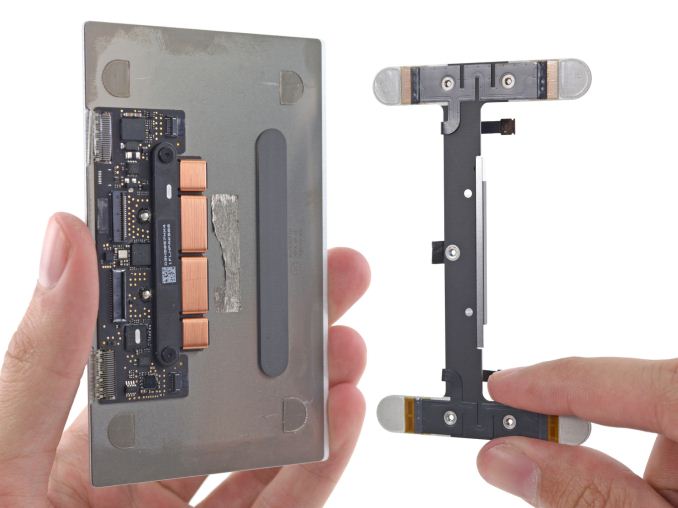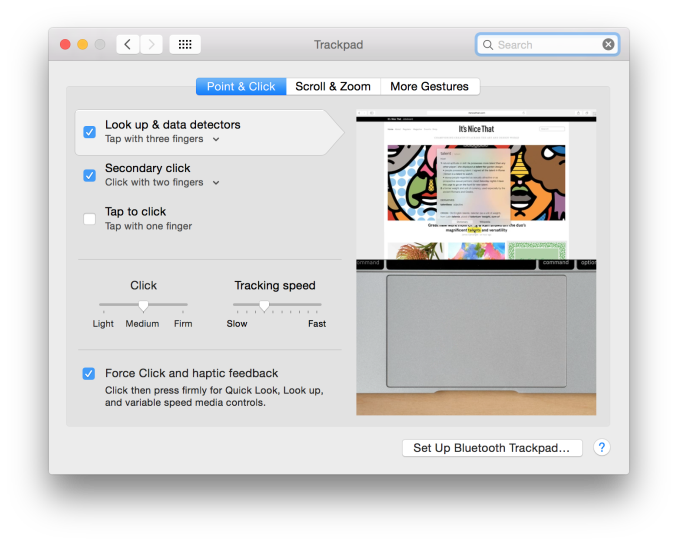The 2015 MacBook Review
by Ryan Smith on April 14, 2015 10:15 AM ESTForce Touch Trackpad
Along with Apple’s changes to their keyboard, the company has also gone in and significantly reworked their trackpad. The new Force Touch Trackpad represents the biggest change to Apple’s trackpad design since the creation of the capacitive, multi-touch pivoting trackpad introduced on the unibody MacBook Pro. In putting together the Force Touch Trackpad, Apple has significantly reworked the internals of the trackpad, creating a trackpad that behaves a lot like their traditional trackpad with some new features, but under the hood relies on some very different mechanisms.
The big change here is that Apple has done away with the traditional pivot and switch mechanism. With pivot and switch, the capacitive trackpad surface would act like a small touchscreen, and underneath it was a switch to register when the trackpad was pressed down. Mechanically the trackpad pivoted from the top (Apple likes to compare it to a diving board), with the trackpad inferring what action to take based on the combination of the capacitive readings and the switch reading. Multi-finger gestures would rely solely on the capacitive layer, primary/secondary clicks would be based on the number of fingers in use when the switch was actuated, etc.
The Force Touch Trackpad on the other hand eliminates the pivot and switch mechanism in favor of a combination of an electromagnet and force/pressure sensors. The pressure sensors essentially replace the physical switch, allowing the trackpad to tell when it has been pressed based on the amount of pressure, and thanks to the pressure sensors it can now tell how hard it has been pressed as opposed to the binary nature of the physical switch. Meanwhile without a physical switch in place to provide the clicking sensation and feedback of pressing down on the touchpad, Apple’s electromagnet – the Taptic Engine – activates to simulate the feeling and noise of pressing a switch.
Update 04/15/2015: iFixit has a great shot of the trackpad's internals, including a good look at just how big the electromagnet/taptic engine really is.
The end result is that the MacBook’s trackpad is among the first wave of devices that ships with Apple’s next generation trackpad and the enhanced capabilities that go with it. Ignoring the pressure sensitivity for a moment (we’ll get back to it), replacing the pivot and switch for an electromagnet works shockingly well. From a touch & feel standpoint the Force Touch Trackpad feels virtually identical to a traditional trackpad, to the point where it’s more than a bit uncanny. In practice you are not actually triggering a switch nor is the trackpad really moving (technically it’s deforming ever so slightly), but it sure feels like you’re working a switch. Apple has clearly done their homework on getting an electromagnet to emulate a switch, to great results. Meanwhile they don’t have the trackpad’s acoustics precisely matching a switch, but the resulting pinball-machine like plunk is close enough to a click that I don’t imagine anyone will mind the difference.
One side benefit of this change is that the trackpad feels the same throughout, and unlike the pivoting trackpad does not require more or less force depending on where you are relative to the pivot point. The variable force required has never been a major problem in my experience, but it is nice to no longer need to worry about where your fingers are relative to the top, and consequently how much force you need to use.
However the bigger deal is that by making the amount of force required to click consistent throughout the entire trackpad, Apple can now use the amount of pressure applied as another input, making the trackpad pressure-sensitive. The underlying pressure sensors and electromagnet are by default programmed to have two levels of feedback – a shallower press is equivalent to a click – and a deeper press brings about the pressure-sensitive “Force Click.” What force clicking does depends on the application, and right now it’s clear that Apple is still experimenting with what they can do with pressure sensitivity. The most obvious uses include line thickness in drawing applications, but the company is also using it for things such as variable speed fast forward and rewinding in QuickTime/iMovie. At times the force click is treated like a 3rd (tertiary) click, and other times the result is based on variable pressure. Since this is a new (and uncommon) feature there’s no global action assigned to the force click – nor does it behave as a middle click on a regular mouse – so what happens is up to the application.
In implementing force click and the Force Touch Trackpad, Apple does offer the ability to control the amount of pressure required and whether force click is active. With force click deactivated the trackpad behaves more or less identical to a traditional trackpad with a single click level. Meanwhile the click pressure setting is interesting, though I’m not entirely convinced it’s all that effective. Short of the tools to actually measure click pressure, I’m not so sure Apple is changing the amount of pressure required to trigger a click so much as they’re changing how hard the electromagnet vibrates. The feedback change is certainly very subtle going from light to firm, and if there is a change in the amount of pressure required then it is certainly equally subtle.
Ultimately whether the Force Touch Trackpad is a major upgrade or not is going to depend on a user’s ability to make use of the force click features. Even turned off, the new trackpad is essentially an improved version of the old trackpad without the minor drawbacks of the pivot mechanism. But with the force click turned on, then it brings new (though not always useful) actions to the trackpad that in turn makes it a bigger upgrade over the old trackpad.
In any case, the MacBook along with the 2015 MacBook Pro 13” are the first wave of devices to implement the new Force Touch Trackpad. Given its expanded capabilities I would expect Apple to eventually replace many (if not all) of their trackpads with this new design. Certainly the 15” MacBook Pro is a likely candidate, as is a future version of the Magic Trackpad. What remains to be seen is whether the next MacBook Air also gets this new trackpad, or if Apple withholds it to keep the products differentiated and to keep the costs of the MacBook Air down.














354 Comments
View All Comments
az060693 - Tuesday, April 14, 2015 - link
You will not be able to output 4k@60hz from the macbook; the intel graphics on the Core M series doesn't support it as per their specifications.BillBear - Tuesday, April 14, 2015 - link
I'm not getting the extreme angst about the USB port.When I want to use multiple devices at once, I tend to be at my desk, whether at home or at work, where a simple USB hub solves the need for multiple ports.
Just because Monoprice doesn't have bog standard USB-C hubs yet doesn't mean there won't be a wide selection of them available soon.
Heck, I've even heard tell of USB docking stations that add features like audio/video out and wired Ethernet to the standard USB hub.
VengenceIsMine - Tuesday, April 14, 2015 - link
I'm one of those disgusted by the single port and I'll explain my reasoning. The whole point of this device type is ease and portability. Unfortunately that is undermined if I need to tote around 2-3 dongles, which while light in weight, add up to more significantly more hassle. Additionally, while occasional, I still run into issues doing things like flashing phones or working with equipment that plugs in via USB that hubs cause compatibility issues. There really was no good reason to design this device with just the 1 USB port other than as a design statement, Samsung made practically an identical device with much more connectivity options. The Air is a great device, not because it is stylish but because it is eminently capable for meeting the needs of most computer users AND because it has great ergonomics and style. Unfortunately for a much larger % of people, through a combination of weaker performance AND design decisions to limit its utility via its connectivity this device will fail to meet the needs of many which is fine but it didn't have to which is rather aggravating. (so are the constantly crappy trackpads on PC's, it doesn't have to be like that)BillBear - Tuesday, April 14, 2015 - link
If the primary thing you value is portability, you probably aren't going to be carrying around multiple devices that need to be plugged into your laptop constantly while you are on the go.VengenceIsMine - Tuesday, April 14, 2015 - link
Actually I do carry around multiple phones but you incorrectly assume that all the devices I plug into are mine and that I carry them with me.BillBear - Tuesday, April 14, 2015 - link
It's perfectly fine that you aren't in the target market, but Apple is betting that enough people are to make production worthwhile.That doesn't change the fact that a simple USB hub fixes the ports problem when you get home or to work where having multiple devices that need to be plugged in at once becomes a likely scenario.
VengenceIsMine - Tuesday, April 14, 2015 - link
Wow, wear blinders much? Like a lot of the potential target market for an ultraportable device, I work in a lot of different places in the course of a month and lugging multiple dongles around seriously degrades the convenience of the form factor. It would be one thing if this was a necessary sacrifice but it wasn't, this was done because someone at Apple decided more than 1 port offended their delicate sensibilities. And to judge by the # of reviewers and comments who have pointed how much that can affect their potential use, it looks a lot like a needless blunder.BillBear - Tuesday, April 14, 2015 - link
OK, so you're basically ignoring reality. The body of this unit is composed of keyboard and battery sandwiched together out to the edge. It's only on top of the keyboard that there is room for ports.Now they could have gotten rid of the two noise cancelling mics and audio in/out jack on the right side, but I suspect people have gotten pretty used to those features.
I imagine that if they had added a second USB port there instead and released a USB-C set of beats headphones and told people to buy those instead, there would have been even larger amounts of OMG Apple butthurt on display.
Dorek - Tuesday, April 14, 2015 - link
The obvious solution is to make the laptop sliiiightly thicker so that they could put a USB-C *and* a 3.5mm jack on one side. Then they could fit extra battery as well. Thinness is only useful to a point.Dorek - Tuesday, April 14, 2015 - link
You don't think the average person walks around with, say, a cell phone and a USB drive? Or a microSD/SD card from their camera? I'd say literally everyone who could afford this computer walks around with at least one of those devices, and they won't be able to use them at all while they're charging.